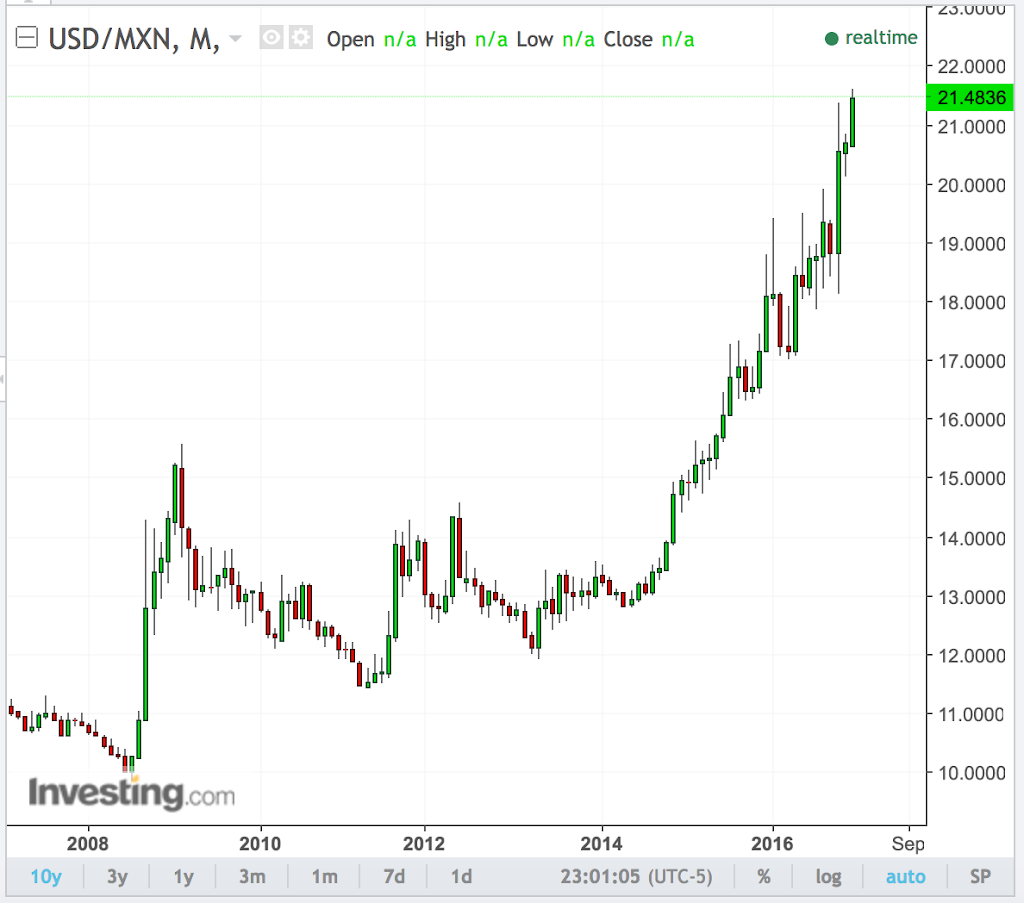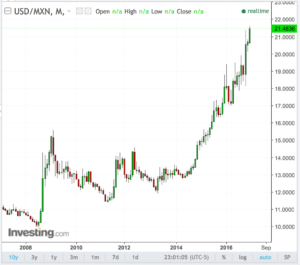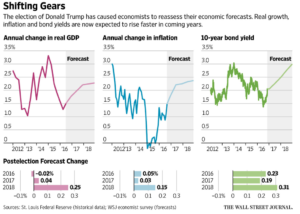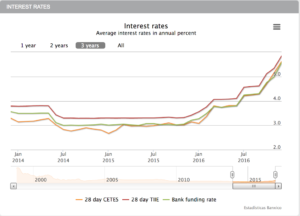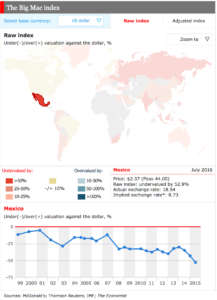Buenos Noches readers. This article’s purpose is to convince you why the Mexican peso (“MXN”) is going to rise against the almighty U.S. dollar.
Introduction:
As a background, we all know who won the U.S. Election. The victory of Donald Trump was a seismic event in history.
- Stocks are rising
- Commodities and precious metals are stumbling
- Bonds are falling
- The smell of inflation is back in the air
- And the U.S. dollar is within arms-reach of parity with the Euro
Together these changes in Capital Markets are called the “Trump Trade.” One victim not just in the markets but in geopolitics, has been Mexico. Mexico has been the “poster child” for everything that has gone wrong with the United States. According to Trump, the NAFTA trade agreement has taken jobs away from hardworking Americans, resulting in a lower standard of living. Did you know that 9 out of 10 cars produced in Mexico get shipped to the U.S. (data sourced from UBS)? And then there’s the issue of immigration. Trump wants to keep Mexicans out. How’s he gonna do that? Well I think we are know that answer!
Despite haven’t become President yet, there has been a real fallout on the Mexican economy and the MXN currency. With every tweet, the Peso keeps declining. It is now conventional wisdom that the MXN will continue to weaken over the next year.
I don’t believe that to be the case. While there’s the Trump Trade, and that’s powerful. There’s also something called the “Madness of Crowds.” This is when every one of us agrees on something whether or not it’s based on logic. There have been examples of Manias in the past, of which some were based on faulty-logic. They include:
· Tulip mania (1637)
· Roaring Twenties (1922-1929)
· Dot-Com Bubble (1995-2000)
· Real-Estate bubbles (2006-2009)
· Bitcoin (present day)
Bubbles usually end badly. The Trump Rally too, will bust. If this happens, it will be the end for the almighty dollar. I would like to give you five reasons why the Mexican peso will reverse course and RISE against the U.S. dollar.
1. First, is something called “selling on the news.” This is a reversal of a market price which goes in complete opposite of what was expected. One often sees this when a company’s share price declines after reporting excellent earnings. This is due to the news already being factored into the share price. Once Trump becomes President, I expect the Peso to reverse its downtrend if rise in earnest by First Half 2017 (think Cinco de Mayo).
2. The U.S. economy won’t move from 2% GDP growth to 4% just because there’s a different guy in the White House. Running the U.S. government is not the same as running the Trump business empire. You don’t just give marching orders and have your plan executed. There’s a whole process to the process, with pushback from Congress, lobbyists, etc. In fact, according to a WSJ survey of economists, 2018 GDP was upwardly revised by just one-quarter of a percent (to 2.4%).
3. Differences in real interest rates affect currencies. The currency with the higher interest rates attracts more investments of which causes an increase in demand for investments denominated in that higher yielding currency. Mexico’s funding rate, for example is nearly double that of U.S 30YR rates. It is true that a proportion of the higher rate is attributed to inflation, though the Bank of Mexico has aggressively raised rates (in each of its last three meetings) to nip it in the bud. One can determine whether or not the difference in interest rates is affecting the currency by looking at forward currency rates. Presently forward currency rates are slightly higher than present rates indicating traders expect to decline slowly.
4. Oil prices are rising: After plunging in 2015, oil prices rose 45% in 2016. Oil prices are expected to remain elevated due to the Nov’16 OPEC agreement. Mexico’s budget is highly dependent on taxes it receives from PEMEX, the national oil company. PEMEX provides nearly 20% of Mexico’s budget and 5% of exports (mostly to the U.S.). Oil is priced in USD so the net effect could be substantial.
5. Purchasing Power Parity: This is an economic theory that determines what the exchange rate should be based on a basket of goods of one country divided by a basket of goods from another country. The Economist magazine popularized using the price of a Big Macin one country over that of another country to determine the exchange rate. Its index shows that the Mexican Peso is over 50% undervalued compared to the USD (and its data was before the U.S. election).
Factors working against a stronger Peso are the continuing Drug Warin Mexico and risk to the Current Account surplus with the U.S. According to the New York Times, in the first 10 months of 2016, there were 17,063 homicide cases in Mexico, already more than 2015’s total and the highest 10-month tally since 2012. The Drug War has become an almost civil war on the country resulting not only in lost innocent lives but in lower potential economic growth.
Mexican’s trade surplusor Current Account could also hamper a strengthening Peso if Trump initiates trade tariffs onto Mexican imports. Exports are typically good for the local peso as U.S. importers would have to convert their dollars in order to pay for the Mexican exports, hence more demand for pesos. However, I believe import tariffs are doubtful as this could lead to a trade war with Mexico.
Conclusion:
The currency market is complex and not every factor I have stated to you will affect the Peso. In summary, I believe the peso will rise due to changing investor expectations, slower U.S. economic growth compared to Mexico, higher interest rates in Mexico, a stronger economy in Mexico due to greater oil exports, and due to Purchasing Power Parity which shows that Big Macs cost just 50% of what they cost here in the U.S. The peso will reverse its downtrend by 1H’17 – think Cinco de Mayo!


